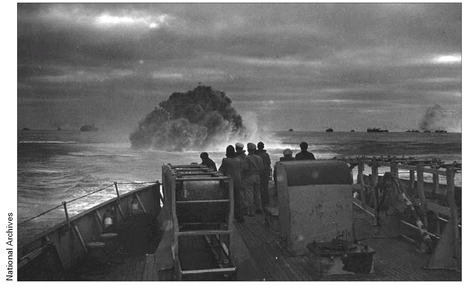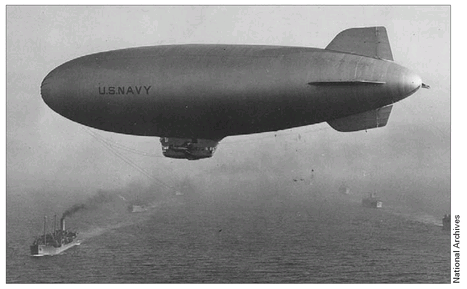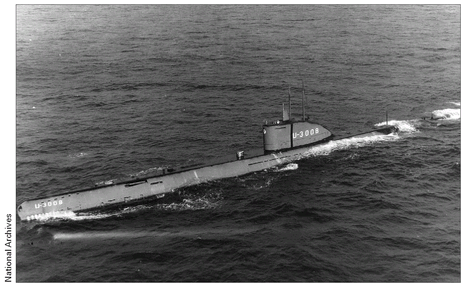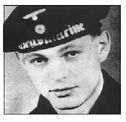War Stories III (25 page)
Authors: Oliver L. North

CHAPTER 9
WAR AT SEA 1941â1945
I
t began on 3 September 1939, a little more than eight hours after Britain declared war on Germany. At 7:30 that evening, 250 miles northwest of Ireland, the German submarine U-30 torpedoed MV
Athenia
âa British-owned passenger liner, killing 118 of the 1,400 passengers and crew. They would be the first of tens of thousands to perish in what Winston Churchill called the “Battle of the Atlantic.”
t began on 3 September 1939, a little more than eight hours after Britain declared war on Germany. At 7:30 that evening, 250 miles northwest of Ireland, the German submarine U-30 torpedoed MV
Athenia
âa British-owned passenger liner, killing 118 of the 1,400 passengers and crew. They would be the first of tens of thousands to perish in what Winston Churchill called the “Battle of the Atlantic.”
When Hitler invaded Poland on 1 September 1939âthe event that precipitated World War II in Europeâhe had only fifty-seven U-boats. They were under the command of Admiral Karl Dönitzâone of the most fervent acolytes in the Nazi cause. Within the span of a year, the number of U-boats at sea and attacking Britain's Atlantic lifeline would doubleâas would Allied shipping losses.
On 29 November 1939, Hitler issued Führer Directive Number 9, authorizing unrestricted attacks against vessels attempting to support the economy or military of Germany's adversaries. From then until the end of the war, Britain's 4,000-ship merchant fleetâthe largest in the worldâwould be under attack from aircraft of the Luftwaffe, surface vessels of Germany's navy, the
Kriegsmarine
(small torpedo-firing and mine-laying
E-boats), and armed merchant raiders. But the greatest threat of all came from
Unterseeboots
âU-boats.
Kriegsmarine
(small torpedo-firing and mine-laying
E-boats), and armed merchant raiders. But the greatest threat of all came from
Unterseeboots
âU-boats.
Â
The crew of the USCG cutter
Spencer
watching explosions sink a German U-175.
Spencer
watching explosions sink a German U-175.

Hitler's goal was simple: to strangle Britain into submission. And it was not beyond the realm of possibility. The British Isles required nearly 60 million tons of imported products annually to support a peacetime economy. Food, raw materials for production, oil, non-ferrous metals, high-tensile steel, fabric for clothing, leather for boots, rubber for tiresâall arrived in England via more than 10,000 shiploads per year. Karl Dönitz told the Führer that if he had 300 U-boats, Britain could be blockaded into capitulation. Hitler set out to give his loyal subordinate what he wanted.
To contend with the threat, the British first turned to the colonies of the United Kingdomâand then the United States. Even before Winston Churchill became prime minister on 10 May 1940, the Roosevelt administration was quietly doing what it could to help. Despite restrictive neutrality laws enacted by Congress, and just days after war began in Europe, FDR authorized the sale of munitions to Canadaâthough it was an open secret that Ottawa would simply transfer whatever it received to Britain.
Â
U.S. convoy en route to England.

On 16 September 1939 the first large transatlantic convoy of war materiel and foodstuffs sailed from Halifax, Nova Scotia, for England. Until the U.S. entered the war, convoys of thirty to forty shipsâshepherded by four to six armed escorts and equipped with “asdic” (British-invented underwater acoustic detection gear) and depth chargesâwould form up off Canada to make the Atlantic transit. For the next two years, convoys of ships under every flag in the British Empire, and many others “leased” by the British from “neutral” nations for the duration of the war, had to run a gauntlet of U-boats, surface raiders, and Luftwaffe attacks in order to reach or leave England.
In November 1939, Congress amended U.S. neutrality laws to permit France and Great Britain to purchase war materiel, provided that American-flagged vessels did not transport the arms. This action made essential arms and equipment more available to the democracies standing against Hitler, but did nothing to improve the delivery of these crucial provisions to those who needed them.
The problem of getting supplies to England was exacerbated even further in June 1940 with the fall of France. By July, Dönitz established
submarine bases in both Norway and the Bay of Biscayâall but eliminating the problems of getting his U-boats out of the Baltic and significantly increasing their area of operations in the Atlantic. The French bases at Bordeaux, La Rochelle, St. Nazaire, L'Orient, and Brestâwhich Dönitz heavily fortifiedâhalved the time it took for his U-boats to transit to their “hunting grounds.” At the same time, the British were forced to recall many of their surface ships and patrol aircraft to defend against the possibility of a German invasion and to fight the “Battle of Britain” against the Luftwaffe. As the number of armed escorts and protective over-flights for convoys dropped, merchant losses increased dramatically.
submarine bases in both Norway and the Bay of Biscayâall but eliminating the problems of getting his U-boats out of the Baltic and significantly increasing their area of operations in the Atlantic. The French bases at Bordeaux, La Rochelle, St. Nazaire, L'Orient, and Brestâwhich Dönitz heavily fortifiedâhalved the time it took for his U-boats to transit to their “hunting grounds.” At the same time, the British were forced to recall many of their surface ships and patrol aircraft to defend against the possibility of a German invasion and to fight the “Battle of Britain” against the Luftwaffe. As the number of armed escorts and protective over-flights for convoys dropped, merchant losses increased dramatically.
The announcementâon 3 September 1940âthat the U.S. would transfer fifty “obsolete” American destroyers to Britain in exchange for leases on British bases in the Atlantic was a morale builder in London, but made the immediate situation even worse. Hitler responded on 6 September by declaring that
all
merchant vesselsâof
any
nationâattempting to deliver
anything
to Britain would be sunk. Dönitz and his U-boats did all they could to implement the threat.
all
merchant vesselsâof
any
nationâattempting to deliver
anything
to Britain would be sunk. Dönitz and his U-boats did all they could to implement the threat.
By the autumn of 1940 German U-boats deployed from France and Norway were operating in “wolf packs” of ten to fifteen U-boats against convoys to and from the British Isles. Losses of ships, cargoes, and crews exploded. In September and October 1940 more than 125 vesselsâ800,000 tons of shippingâwent to the bottom. Had winter weather not curtailed U-boat operations in the North Atlantic, it would have been worse.
Then, in December 1940, just weeks after his re-election for an unprecedented third term, FDR set out to change the equation. Publicly proclaiming that the U.S. had to be the “Arsenal of Democracy,” he urged Congress to pass “Lend-Lease”âallowing the British to “borrow” or “buy-now-pay-later”âfor arms, munitions, ships, and planes. In anticipation of congressional approvalâwhich came in March 1941âAmerican shipyards immediately commenced work on dozens of destroyers, destroyer-escorts, and cutters. Roosevelt also extended the U.S. “neutrality zone” east to Bermuda and all the way north to Iceland. He ordered the new U.S. Atlantic
Fleet to commence escorting convoys within this zone, thus freeing up British ships for operations closer to home.
Fleet to commence escorting convoys within this zone, thus freeing up British ships for operations closer to home.
Despite these changes, by the spring of 1941 shipping losses were again on the rise. With better weather, bigger U-boat wolf packs returnedâand this time, the brand-new battleship
Bismarck
âthe pride of Hitler's surface fleetâcame with them.
Bismarck
âthe pride of Hitler's surface fleetâcame with them.
When the British Admiralty discovered that the most powerful battleship in the world had sortied for the Atlantic, every available ship in the British Fleet was ordered to give chase, and merchant ships in eleven convoys scattered for the nearest friendly port. By the time the
Bismarck
was sent to the bottom on 27 May, the battleship HMS
Prince of Wales
had been badly damaged, the battle cruiser HMS
Hood
had sunk with all hands, and President Roosevelt had declared an Unlimited National Emergency.
Bismarck
was sent to the bottom on 27 May, the battleship HMS
Prince of Wales
had been badly damaged, the battle cruiser HMS
Hood
had sunk with all hands, and President Roosevelt had declared an Unlimited National Emergency.
In June of 1941, Hitler invaded Russiaâfurther complicating the maritime supply situation, and bringing the U.S. ever closer to an armed confrontation. In August, the U.S. and Royal navies began escorting convoys laden with Lend-Lease supplies headed for Murmansk. On 4 September, the destroyer USS
Greer
, alerted by a British patrol plane, pursued U-652, which had been shadowing a convoy. When the U-boat fired a torpedo at its antagonist, the
Greer
responded with a depth charge attack. Then in October, the USS
Kearney
was damaged, and U-boat torpedoes sank the USS
Reuben James
. Both destroyers were defending convoys from wolf pack attacks when the attacks occurred.
Greer
, alerted by a British patrol plane, pursued U-652, which had been shadowing a convoy. When the U-boat fired a torpedo at its antagonist, the
Greer
responded with a depth charge attack. Then in October, the USS
Kearney
was damaged, and U-boat torpedoes sank the USS
Reuben James
. Both destroyers were defending convoys from wolf pack attacks when the attacks occurred.
By late autumn of '41, the weather in the North Atlantic once again curtailed U-boat operations. When Pearl Harbor was bombed on 7 December 1941, there were only a dozen German submarines operating along the British-Russian maritime supply routes. Though surprised by the Japanese attack, Dönitz quickly put together a plan for a massive U-boat strike against shipping lanes just off the American mainland. But on 11 December, the day Hitler declared war on the United States, he was directed by the Führer's senior staff to keep the bulk of his undersea fleet close to home.
Undeterred, Dönitz devised Operation
Palkinshlog,
or “Drumbeat”âusing only five 1,100-ton, Type-9 U-boats. On the night of 23 December 1941, the five submarines deployed from L'Orient, France, for the 3,500-mile trip across the Atlantic. A week later, in a successful effort to confound Allied convoy planners, he dispatched a six-boat wolf pack of his smaller 740-ton U-boats to the waters off Newfoundland.
Palkinshlog,
or “Drumbeat”âusing only five 1,100-ton, Type-9 U-boats. On the night of 23 December 1941, the five submarines deployed from L'Orient, France, for the 3,500-mile trip across the Atlantic. A week later, in a successful effort to confound Allied convoy planners, he dispatched a six-boat wolf pack of his smaller 740-ton U-boats to the waters off Newfoundland.
The operation was a stunning successâmade more so by the lack of American preparedness for such an onslaught in waters off the East Coast. In just three weeks, starting in January 1942, the Drumbeat gambit sent twenty-six American vessels, 162,000 gross registered tons of shipping, and 252 American merchant seamen to a watery graveâmany times within sight of land. Some called it “the Pearl Harbor of the Atlantic.” The Germans called it “Happy Time.”
For the next ten months Allied shipping losses were devastatingâparticularly along the U.S. East Coast and the Gulf of Mexicoâwhere no convoys or protective procedures of any kind had ever been implemented. By April, U-boats had sunk eighty-seven shipsâmore than 500,000 tons. In May, Dönitz shifted south to the Gulf of Mexico, sinking another forty-one ships, mostly tankers. And though there were never more than a dozen U-boats operating along the U.S. east coast at one time, the worst was yet to come.
Â
U-3008 on patrol.

The warm waters of the Gulf Stream, just east of the American mainland, offered both lucrative hunting grounds for the U-boats and a welcome respite for German submariners who had been fighting in the cold waters of the North Atlantic for better than two years. One of those Germans who saw the U.S. for the first time from the deck of a U-boat was Peter Petersen. He was a nineteen-year-old diesel machinist when he joined the crew of U-518. Petersen had grown up near the Danish border and volunteered for U-boat service after he was drafted. He made three deployments to the U.S. coast starting that spring of 1942.
PETER PETERSEN
Machinist Mate,
Kriegsmarine
Aboard U-518
14 November 1942
Kriegsmarine
Aboard U-518
14 November 1942

I volunteered for the U-boats because the pay was better and I thought that the guys on those boats were very brave. Our mission was simply to sink ships. My U-boatâU-518âwas just one of 1,154 submarines that Germany built during the war. Each of the boats our sizeâand there were some largerâhad a crew of about fifty-five men, and each could carry up to twenty-two torpedoes.
When we got to the American east coast in the spring of 1942, it was a shooting gallery. We found it very easy for us to sink ships there, because there were no convoys, no escorts, and no patrol aircraft at all on our first deployment. The American navy was nowhere to be seen. And the merchant ships had no idea how to handle it.
We were able to swim in the Gulf Stream during the day, take the sunlight on the deck, and listen to American music on the radio. We didn't need to operate in wolf packs because there were so many individual shipsâ
tankers and transportsâtraveling up and down the east coast without escorts. We would arrive on station off an American port like Charleston, post a lookout, and just wait for the ships to come steaming out.
tankers and transportsâtraveling up and down the east coast without escorts. We would arrive on station off an American port like Charleston, post a lookout, and just wait for the ships to come steaming out.
Unlike the cities of Europe, American cities still had their lights on at night, making it easy to see the silhouettes of our targets. Some of them even steamed with their lights on. These slow-moving merchant ships were like sitting ducks.
On our first trip to the American coast, my boat, U-518, operated with U-123. Captain Hardegen, our leader, was a “drumbeater.” He was a tough commander but a very successful one. On April 7, Captain Hardegen made an entry in his
kreigstaag
logbook, “We are marching again, tight along the landâfrom lighthouse to lighthouse that burn brightly as if during peace time.”
kreigstaag
logbook, “We are marching again, tight along the landâfrom lighthouse to lighthouse that burn brightly as if during peace time.”
I'll give you an example of a typical attack. On April 8, 1942, both of our U-boats were patiently waiting for our next kill off the coast of Georgia. Shortly after midnight, Captain Hardegen spotted an American tanker proceeding northward. It was the SS
Oklahoma,
a Texaco tanker.
Oklahoma,
a Texaco tanker.
Sometimes we would attack unescorted merchant ships with our deck gun, but this time, because we were so close to shore, he fired a torpedoâbut it missed. We had to speed on the surface to catch up with the tanker and an hour and a half later he tried again. This time he hit his targetâand the ship exploded instantly. It must have been carrying gasoline.
There were so many unescorted ships that we used up all of our torpedoes in just a few weeks and we had to go back to France to get more. This was the hard part of the tripâbecause we never knew when we were going into one of the bases in France if we were going to be attacked by British aircraft or ships.
Later on, after the Americans started convoys off the east coast, we took U-boats into the Gulf of Mexico. And when they started escorting down there, we moved further southâoff the Panama Canalâand eventually all the way to Brazil. For those kinds of trips we would have to be resupplied and re-fueled at sea. For that, we had
“milch cow”
resupply submarines
or merchantmen converted into tenders and we would replenish our fuel, food, torpedoes, and ammunition at sea.
“milch cow”
resupply submarines
or merchantmen converted into tenders and we would replenish our fuel, food, torpedoes, and ammunition at sea.
As the war went on, it got more dangerous to be in a U-boat. The British and Americans built more ships than we could sink. Their sonar, radar, and depth charges got better and more effective. Long-range airplanes with radar were a very big threat. Boats like U-518 actually spent most of the time on the surface, because we couldn't stay down very long on our batteries. The biggest threat we faced was from airplanes that could spot us from the air with radar and drop bombs and depth charges on us and then call to a destroyer to finish us off.
When I completed my last deployment to the United States, we returned to our base in Norway. When we pulled into our base, we had been at sea for a total of 333 days. The first day ashore we could barely walk, because we had been confined to the U-boat for so long. The U-518 was a very good boatâbecause we made it back. Most of us didn't. Serving on a submarine in the Atlantic was very dangerous. Eighty percent of us did not come back.
Other books
The Ask by Sam Lipsyte
Alan Price and the Statue of Zeus (The Nephilim Chronicles Book 3) by Jonathan Yanez
Died with a Bow by Grace Carroll
The Sellsword by Cam Banks
Convict: A Bad Boy Romance by Roxie Noir
The Novice by Canavan, Trudi
A Twist of Date by Susan Hatler
A Dragonlings' Easter (Dragon Lords of Valdier 6.5) by Smith, S. E.
Naked Moon by Domenic Stansberry
Hannah's Gift by Maria Housden
